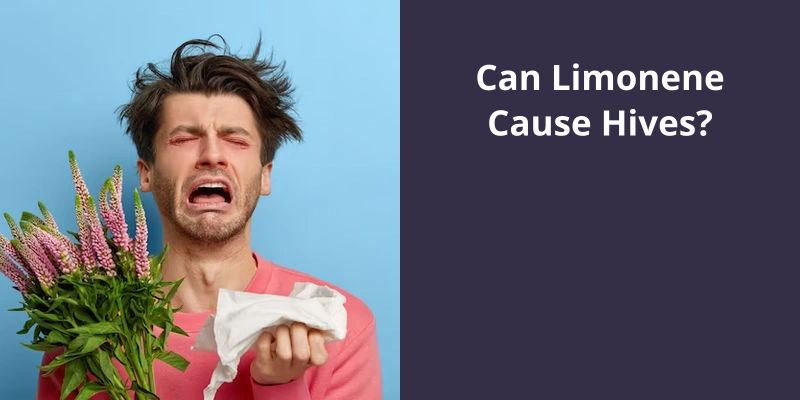Yes, limonene can potentially cause hives. Limonene is a common ingredient in many household products and is known to cause allergic reactions in some people. The reaction occurs when the immune system identifies limonene as a foreign substance. This triggers a release of histamines that cause inflammation and other symptoms, such as hives. However, it’s important to note that not everyone who is exposed to limonene will develop hives or other allergic reactions. It primarily affects individuals who are specifically allergic to this substance.

Is Limonene a Skin Irritant?
Limonene, a commonly used chemical found in many household products and cosmetics, has the potential to cause skin irritations. These symptoms are indicative of contact dermatitis, a condition characterized by inflammation of the skin.
Moreover, it’s important to note that individuals can also be allergic to limonene. Allergic reactions can manifest in various forms, including hives. Hives are itchy, red welts that appear on the skin and can be triggered by an allergic response.
A dermatologist can conduct patch testing to determine whether you’ve a sensitivity or allergy to limonene. They may also recommend avoiding products that contain this chemical to prevent further skin reactions.
Inhalation of limonene vapors can lead to coughing, wheezing, and shortness of breath, particularly in individuals with pre-existing respiratory conditions such as asthma.
Given the potential for negative reactions, it’s advisable to exercise caution when using products that contain limonene. Reading ingredient labels and opting for fragrance-free or hypoallergenic alternatives may be beneficial, especially for individuals prone to skin sensitivities or allergies.
The Potential Effects of Limonene on the Environment, Such as It’s Persistence in Wastewater and It’s Impact on Aquatic Organisms
- Limonene is a commonly used compound found in many household products.
- It’s been found to persist in wastewater due to it’s slow degradation rate.
- This can lead to potential environmental contamination when wastewater is released into water bodies.
- Aquatic organisms may be exposed to limonene, which can have negative effects on their health and behavior.
- Limonene has been shown to be toxic to certain aquatic organisms, such as fish and invertebrates.
- Exposure to limonene can affect their growth, reproduction, and overall survival.
- Studies have also found that limonene can interfere with the natural balance of aquatic ecosystems.
- It can disrupt the food chain and alter the composition of aquatic communities.
- Efforts should be made to minimize the release of limonene into wastewater and develop methods for it’s effective removal.
- Regulations and guidelines can help to ensure the proper management and disposal of products containing limonene.
Food allergies can cause a range of symptoms, but one of the most common and easily recognizable signs is the presence of hives all over the body and swelling of the face. These hives are characterized by raised pink bumps with pale centers, resembling bug bites. However, it’s important to note that severe allergic reactions can be life-threatening and may involve difficulty breathing and swallowing.
What Do Hives From Food Allergy Look Like?
Food allergies can manifest in various ways, but hives and swelling of the face are among the most common symptoms. Hives are characterized by raised pink bumps with pale centers, resembling bug bites. These specific welts can appear all over the body, indicating a systemic allergic reaction. In some cases, the face may also become swollen, further exacerbating the discomfort.
It’s important to note that while hives alone can be distressing, severe allergic reactions can have life-threatening consequences. When hives occur alongside symptoms such as difficulty breathing and swallowing, prompt medical attention is crucial. These signs suggest an anaphylactic reaction, a severe and potentially fatal response to a food allergen.
The appearance of hives on the skin is often an indication of the immune system releasing histamine in response to an allergenic trigger. In the case of food allergies, this trigger can be a specific ingredient or component in the food consumed. Limonene, a naturally occurring compound found in citrus fruits, is sometimes associated with allergic reactions, but it’s exact role in causing hives isn’t yet fully understood.
They can conduct proper diagnostic tests to determine the root cause of the reaction and provide appropriate guidance on managing your symptoms and avoiding potential triggers. Remember, accurate diagnosis and proper management are essential for preventing future allergic reactions and maintaining your overall well-being.
In addition to the common allergenic foods mentioned earlier, there are certain ingredients in food that can trigger symptoms like flushing, itching, and hives, even if one doesn’t have a true allergy to the food itself. These ingredients, such as food additives, preservatives, and flavor enhancers, can often be the culprits behind allergic-like reactions. It’s important to be aware of these potential triggers and pay attention to ingredient labels when managing symptoms.
What Food Sensitivities Cause Hives?
These ingredients are known as histamine-releasing or histamine-promoting foods. One example is histamine-rich foods like aged cheeses, fermented products, and certain types of fish. Histamine is a compound that can trigger hives and other allergic symptoms in some individuals. Other ingredients that can cause hives include food additives like food coloring and preservatives.
In addition to specific food ingredients, some individuals may also experience hives due to a condition called oral allergy syndrome (OAS). OAS occurs when the immune system reacts to proteins found in certain fruits, vegetables, and nuts, which are similar to pollen proteins. For example, someone allergic to birch pollen may experience hives after eating apples, cherries, or almonds.
It’s also worth noting that certain food intolerances can cause skin reactions resembling hives. For example, individuals with lactose intolerance may experience hives or other skin symptoms after consuming dairy products. This isn’t an allergic reaction but rather a result of the bodys inability to properly digest or process certain components in the food.
If you suspect that a specific food or ingredient is causing your hives, it’s important to keep a food diary and track your symptoms. This can help you identify patterns and potential triggers. It’s also advisable to consult with a healthcare professional, such as an allergist or dermatologist, who can perform tests to determine the cause of your hives and provide appropriate treatment options.
Conclusion
By understanding and taking necessary precautions, individuals can effectively manage their allergies and maintain a healthy and comfortable lifestyle.





